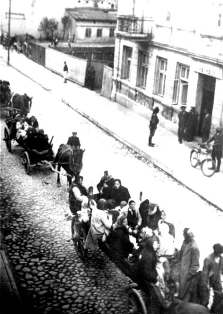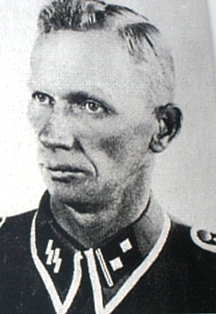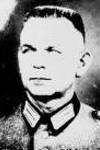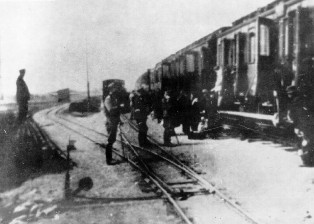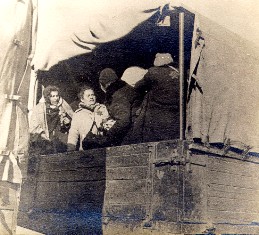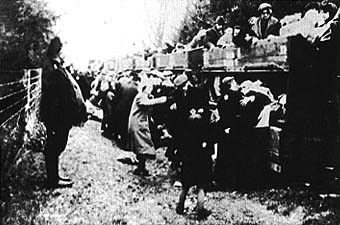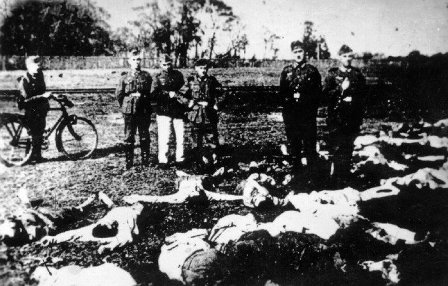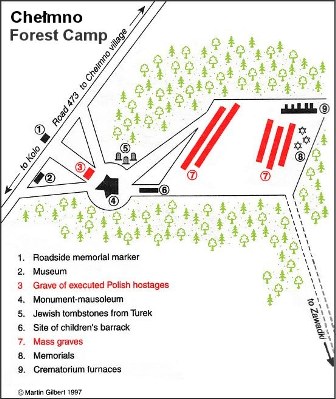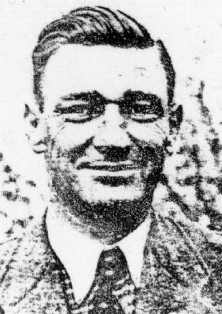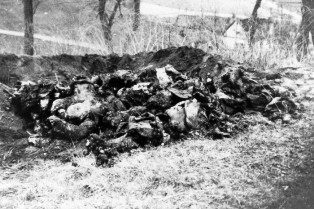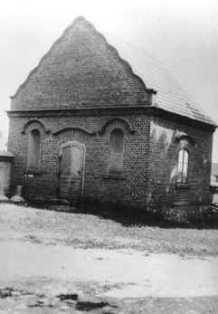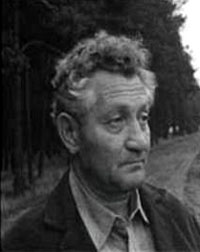Holocaust Education & Archive Research Team |
|
Trials Introduction to the Holocaust Trials
Trials
Interrogations & Testimonies
The IMT Series Nazi Justice
| |||||||||||||||||||||||||||||||||||||||
Bruno Israel Chelmno Wachtmeister - Testimony Protocol of the Interrogation of Accused – Suspect
On October 29 1945 in Lodz
Examining Judge of the third region of the District Court in Lodz - Wladyslaw Bednarz.
Assisted by Recording Clerk - In the presence of the parties -heard a defendant whose name is mentioned below.
The defendant is accused of committing a crime arising from Art. 1 of the PKWN decree (Polski Komitet Wyzwolenia Narodowego – Polish National Liberation Committee).
After being informed of the nature of the crime he is being charged with and of the right to refuse to answer the questions asked, the defendant testified the following:
The defendant claims to be not guilty of the crime.
Before the war I worked as a dyer in the “Leber & Lewandowski” company. I signed the Volksliste in 1940 and started working for the Hilfspolizei in 1941.
In 1943 I was drafted into gendarmerie as Wachtmeister. Later, after being assigned to the Sonderkommando Kulmhof, I was promoted to the rank of Oberwachtmeister.
I would like to point out that all the gendarmes assigned to Kulmhof (Chelmno) were at least Oberwachtmeister’s. Only two gendarmes had the rank of Wachtmeister. I can recognise them in photographs number 8 and 9(files: sheet 155). I cannot recollect their names. Besides, there was Rottwachtmeister shown in photographs number 1 and 2 on card 122.
In July or August 1944, while I was doing service at the fourth police-station of the State Police, I was assigned to the Sonderkommando Kulmhof. As far as I can remember, 22 gendarmes were assigned at that time.
Among them were Arthur Sliwke and Hutner (I cannot remember his first name) from Leipzig. The gendarmes in the photographs on card number 155 had been assigned earlier to the Sonderkommando and were already in Kulmhof when I arrived.
The commander of the Sonderkommando Kulmhof was Haupsturmfuhrer Johann Bothmann (tall, red-haired, aged 36, with a slightly freckled face). His deputy was Hauptscharfuhrer Piller (it seems to me that his first name was Willi). He was a member of the SD and wore a relevant stripe on his sleeve.
In addition, he had a “Prinz Eugen” stripe on his sleeve. He was a stout blond man, aged about 36-40. Others who belonged to the Sonderkommando Kulmhof were: Untersturmfuhrer Heffele (Hafele), I do not know his name, tall, aged about 50, very stout. He was the commanding officer of the Hauskommando. The commanding officer of the Waldkommado was Lenz.
Hauptscharfuhrer Johann Runge (shown in photograph number 14 on card number 156 of the files) was a supervisor of one of the crematoriums. He was marked by extreme cruelty and I saw him hitting Jews on their backs with an axe. Where he came from – I do not know.
Here the defendant was shown photograph number 15 on card number 155. The photograph shows Unterscharfuhrer Kretschmer, he also worked at the crematoriums. Hauptscharfuhrer Gustav Laabs was a driver of the so-called Sonderwagen, cars used for gassing Jews.
Photograph number 13 on card number 156 shows Laabs. Laabs was also cruel to Jews. Photograph number 11 on card 156 of the files shows Buerstinge (Burstinger) Hauptscharfuhrer. I cannot remember his first name or place of residence. A canteen manager was a tall handsome blond man named Erwin Schmidt (Hauptscharfuhrer), who came from the Sudeten.
Oberwachtmeister Sommer (I do not know his first name) was a cashier. He was short and slim. His direct superior was Hauptscharfuhrer Gorlich, (I do not know his first name), short, stout, aged about 40.
Bothmann’s chauffeur was Unterscharfuhrer Walter Burmeister, of middle height, tall, aged about 40 – 45. Hauptsturmfuhrer Richter (tall, slim, dark –haired, aged about 40) was responsible for valuables. Among the gendarmes I can remember one more name – it was gendarme Scheffel. Commanding officer of the gendarmes was Leutnant Burmeister (I cannot remember his first name).
After our arrival the leutnant told us that we would be doing sentry duty, Bothmann added that we should not say a word about what we were about to see or else we would be dead. In addition to our salary we received a bonus of 13 RM (Reichmarks) a day, paid by Bothmann himself.
At the time of my service in Chelmno, two transports of Jews arrived, each carrying about 700 -800 people. Among them there were many Jewish people from abroad and Alt-Reich. The transports came to Kolo by rail, where they were loaded into narrow –gauge railroad cars and carried to Chelmno.
I took part in the escorting of the transports. When Jews asked where they were being taken, I answered, in compliance with the instructions that they were going to work. The Jews generally believed it and behaved peacefully. When in the church, one Jewish woman started screaming that the Jews would be gassed; she was led out of the temple. I do not know what then happened to her.
I would like to point out that the Jews, after being brought by rail (at about 5pm) were located in the church for the night. There some bread and water were prepared for them.
Here the hearing was adjourned.
The hearing was re-opened on October 30, 1945.
The Jews were transported from Kolo to Chelmno in 15-17 railroad cars. I cannot remember the number exactly. The last two cars carried baggage. The baggage was dropped in the place where the railroad track crossed the road. The same day it was brought to a large barrack in Chelmno, where it was sorted.
As I have already mentioned, the Jews stayed in the church overnight. It was really crowded. As far as I can remember, there were instances of deaths among the transported Jews. I have never witnessed gendarmes or SS –men kill any of the transported Jews. Bothmann issued an order forbidding to maltreat Jews. This was to keep up appearances and make the Jews uncertain of their fate.
If the Jews had known what fate they could expect, our job would have been much harder. For instance, the whole transport from Kolo to Chelmno was escorted by only 6 gendarmes. If the Jews had known what was going to happen, they could have dispersed easily.
Transportation of the Jews to the Chelmno Forest started at 7am. For this purpose three covered trucks were used. Each of them carried 40-50 people. They were counted while getting on and off the trucks. The escorting gendarmes had been warned that if anybody escaped from the truck, the gendarmes would be incorporated into the transport bound for execution.
Each transport was escorted by two gendarmes. There were no instances of escape. Each truck made 2-3 and sometimes even 4 rounds a day. But in some cases only half of the transport was executed during one day. Then the other half was killed the following day. The work generally at 4pm. Those Jews who were still alive slept in the church, just like the night before.
We did not have to hurry while doing our job. Gendarmes and SS-men said that in 1942 they “were doing 1,000 – 1,200 people a day.” The transport brought by the three trucks was unloaded in the Chelmno forest in the clearing in front of the barracks. The transported Jews were addressed by Bothmann, who told them that they would go to work in Munich or Leipzig and he would lead them there.
He presented himself as harsh but reliable and added that no harm would be done to them. He also said that the elderly would do service inside, while the younger ones outside. Then he announced they had to take a bath. The Jews had to undress in the barrack – men separately from women.
Each person had to put his or her clothes and underwear on a shelf, while rings and other valuables on a shelf above their clothes. Then all of them, both men and women were herded into a corral at the exit of which there was a Sonderwagen (the van). The Jews were violently rushed into the van.
Then screaming and lamenting could be heard. I cannot remember the names of the gendarmes who herded the Jews into the van. There were three of them. They are in none of the presented photographs.
One of the Gendarmes whose name I cannot recall was Sliwke’s brother-in-law. Also the SS-men helped to rush the Jews into the vehicles. The Jews were told that they would be taken to the bath-house by van. They were given soap, unless they had their own. They were told they would get towels at the bath-house.
The Jews sometimes remained calm even when inside the van, Laabs locked the van’s door and started the engine. But earlier he crawled under the vehicle and connected the exhaust pipe with the pipe coming out of the engine.
I wish to point out that the exhaust pipe entered the inside of the van through the floor, so the exhaust fumes, after the engine had been started, entered the vehicle killing all those inside. I do not know if the gasoline was mixed with chloroform, ether or other substances. I have never heard about it from anyone.
After a few minutes the van started rolling from in front of the barracks in the direction of the crematoriums located in the same clearing, but closer to the entrance. After the van stopped in front of the furnace, the door was opened. Waiting for the gas to evaporate took some time. Then some Jewish workers went into the van and threw out the dead bodies. Next a few workers searched the corpses pulling out gold teeth. The bodies were thrown into one of the crematoriums.
The furnaces were about 10 meters wide and about 5-6 meters long. They did not stick out above the ground level. They had no chimneys. They became narrow towards the bottom, where they ended with grates made of rails. The rails are shown in photograph number 7, card 173.
The shorter rails are the grates, while the longer ones were used to camouflage the crematoriums from pilots. The rails were placed on the edge of the holes and covered with sheets of metal. I have heard that in 1942 this place of execution was raided and bombed by pilots. Layers of corpses in the furnaces were separated with layers of chipped wood.
As far as I can remember, the fire was set at the bottom, so the person setting it had to go under the grate through an ash pan. I wish to point out that the ash pan could be reached through an underground corridor used for removing the ash and enabling the appropriate draft. The corpses burnt quickly and next layers were thrown on the top. In some cases Jews thrown out of the vans, who were thought to be dead, revived. Then they were killed with a gunshot.
I heard that Runge threw one of the Jewish workers to the furnace for some offence. The Jew got out of the furnace and worked till evening. In the evening he was shot. Once I saw Bothmann kill one of the Jewish workers. I suddenly felt sick and went to gendarme Bollman to have a cigarette.
A lieutenant saw it and I worked inside the clearings ever since. I was to be punished for not having strong nerves to do my job. The ash was removed with a poker with an iron bar at one end. The bones were separated from the ash and crushed with special pestles on a cement slab. Then the bones and ash were put into sacks and at night dumped into the Warta River, next to the mill in Zawadki.
The crushed bones looked like the bone fragments shown to me (the defendant was shown the bone fragments described in examination protocols sheets 405, 406, 407). The ash and bones were driven away by Laabs, Runge and Kretschmer. The loaded trucks waited in Chelmno until 11 or 12 o’clock in the night and later set off in the direction of Kolo.
At the execution site in the Chelmno forest two barracks had been built, one bearing the inscription “Durchgangslager,” in which the Jews undressed, and the other was a small barrack where the clothes and underwear were stored. They were transported to Chelmno on the same day.
The valuables were given to Richter and Gielow who placed them in an iron chest. Richter kept the key to the chest. I do not know how the valuables were transported to Lodz. The clothes and baggage were searched through by the Jewish workers in a special barrack in Chelmno. The valuables were also kept in Richter’s custody.
In Chelmno there were two death vans. At the time of my stay in Chelmno generally only one of them was used. The other one, the smaller one, with the carrying capacity of 80 persons, was kept in Chelmno in reserve. Both vehicles were sent to Berlin, to which city they were driven by Laabs and Runge. The men were not (in Chelmno) for over a week. Apart from this there was one more van, used for disinfecting clothes.
The van had its wheels taken off. I do not know if it was ever used to gas people. But clothes were hung inside the van and underwear was placed on special benches. Next a washbowl with burning sulphur was put inside and the van was locked for the night. The photographs presented to me (the defendant was shown the photographs on card 397 and 398 of the files) show the van, I have just described.
Old underwear was torn into pieces with the use of a purpose-brought machine called “wolf.” I would like to point out that Jews had to strip naked before the execution. Only in a few cases women were allowed to keep their panties on. The underwear – tearing was done by three Jewish brothers whose names I cannot remember. I did not hear about larger transports intended to come to Chelmno in the second half of 1944.
In December 1944 the liquidation of the camp started, the crematoriums were destroyed. The bricks were driven away, but I do not know where exactly. A special commission came to check whether the work is properly done. It was stated that at the bottom of one furnace there were still some concrete, which had to be removed. Presently, there is no trace of the crematoriums.
There were about 80 Jewish workers with the number constantly fluctuating. They were often killed, most frequently by Bothmann and Lenz. The other SS-men also killed the Jews, especially the weaker ones or those who committed any offence.
The gendarmes with one exception – Sliwke did not kill Jews, but Sliwke killed a Jew named Finkelstein, when the latter was trying to escape. The Jews were beaten and harassed. The most atrocious towards Jews were SS-men and some gendarmes, for example Sliwke.
The Jewish workers had shackles on their legs.They were divided into Hauskommando and Waldkommando.The former was supervised by Hafele, while the latter by Lenz, with Runge as his deputy. The Jews lived in the palace granary in Chelmno. The workers lived on the first floor while shoemakers and tailors working for the Sonderkommando and various German dignitaries, such as Greiser, Biebow, and others, on the second floor.
Bothmann for example, had 17 pairs of shoes. Old clothes, papers, photographs were burnt in a ground hole at the edge of the park, next to three apple trees. I can indicate this place. The fire was burning there day and night. Once I found a photograph of a Jewish family I knew – the Smietana family – and wanted to take it. Lenz saw that and tore it into pieces.
Once, as far as I can remember, Gauleiter Greiser visited Chelmno. I do not know if Himmler was there too. I did not receive any bonus from Greiser. Leutnant warned us to be extremely careful not to let any unauthorised person enter the execution site in the Chelmno Forest.
He told us about an incident of entering the grounds by the “English Secret Service” and added that, bearing this negligence in mind, we should duly secure the area to prevent any further incidents of that kind. I am not acquainted with the details related to this case. A few times I saw Dr. Bradfisch and Biebow in Chelmno. However, I do not know the aim of their visit.
Our trucks transported piles of formerly Jewish clothes to the N.S.V. in Lodz and other neighbouring cities. Jewish badges sewn on the clothes were removed. I was never in such transports. I did not see local Volkdeutsches coming to get any of the clothes. Taking photographers and even possession of photo cameras was forbidden. In spite of the regulation, gendarme Ruwenach had a camera and took photographs. The prints were made in Kolo in a studio whose name is unknown to me.
The photographs on file card number 330 may have been taken by Ruwenach. His camera allowed taking photographs of a similar format. But I have never seen this photograph before. I suppose it presents naked Jews before gassing. The gendarmes in the photographs on file card number 384 and 385 are unknown to me. The only Sonderkommando member who had a dog was Runge.
I had never heard the number of Jews executed in Chelmno between 1942 – 1943 mentioned by any member of the Sonderkommando. It was said that the members had been fairing better during those years. There had been more food and they had fared better. They told us about expeditions to Gniezno, Obomiki, Wagrowiec and Birnbaum. In all those places they burnt corpses taken out of graves situated in the forest. They took with them Poles working in the Chelmno camp. I do not know the Poles names.
At the time of my stay in Chelmno only Jews were being executed. I did not know that earlier Poles and Russians were brought to Chelmno. And I did not see transports carrying children or the mentally ill. I heard that in 1942 two Jews managed to escape from the Chelmno camp. I do not know if more did. During my stay in Chelmno only one Jew – Finkelstein – made an escape attempt.
On the night of January 16, 1945, we were woken up and ordered to pack our stuff. We were told about the advancing Russians. Then Lenz was leading the Jews out of the granary in fives and Bothmann killing them with a back-head shot. Suddenly Zurawski sprang from the granary, fought his way through the SS-men and escaped, running across my path about 6-7 metres away from me.
In spite of Bothmann’s order, I did not shoot. Bothmann, Kretschmer, gendarme Daniel, and others started chasing him. However, I did not know anything about Srebnik’s escape.
The Sonderkommando left for Poznan, while the gendarmes stayed in Kolo. We got to Poznan by military vehicles. There we found Bothmann and demanded due payment and provisions. Bothmann and Piller answered they had nothing for us and we were not paid any money. I wish to point out that after Zurawski escape Lenz and gendarme Haase went inside the granary in order to force the Jews to go out. However, the Jews hanged Lenz and shot Haase.
In such circumstances Bothmann ordered to fire incendiary bullets at the granary. The fire which broke out, consumed all Jews inside. Shortly before the incident there were 45 Jewish workers in Chelmno. I do not know anything about the order demanding the liquidation of the Haftlings (prisoners). The personnel left Chelmno so late because they had to wait for Greiser’s order.
Additionally I wish to explain that the Jews before being gassed, wrote letters to their families informing about their departure to the Reich. For this reason, 10-15 Jews were separated from each transport in order to write such letters. How they were later killed, I do not know.
The purpose of writing the letter was to comfort other Jews working in the ghetto, thus making our future work easier. In order to conceal our real intentions towards the Jews, such inscriptions as “Arzt” and “Baderaum” were made in the barracks where they undressed before being gassed.
I would like to point out that the Jews were so much misled that after Bothmann’s speech that they shouted out words praising Germany. I do not know where all the papers were taken after the Chelmno camp had been liquidated. I know, though, that one truck loaded with papers left for Poznan.
Here the protocol was closed and, after being read, signed.
* photos added to enhance the text
Source:
Chelmno Witnesses Speak - The District Museum Konin 2004 Lodz Polish State Archives (Naczelna Dyrekcja Archiwów Państwowych) Holocaust Historical Society Map courtesy of Sir Martin Gilbert Yad Vashem USHMM
Copyright Victor Smart H.E.A.R.T 2009
|
